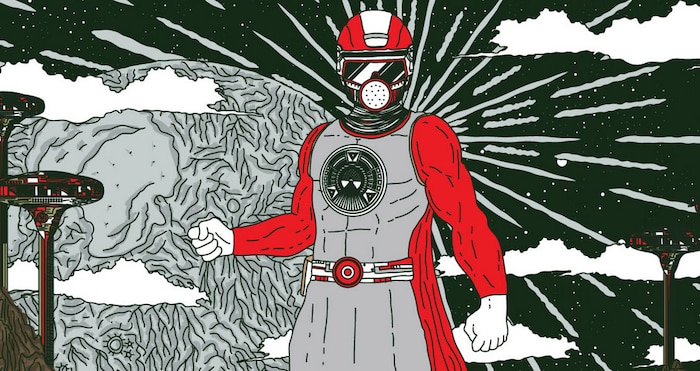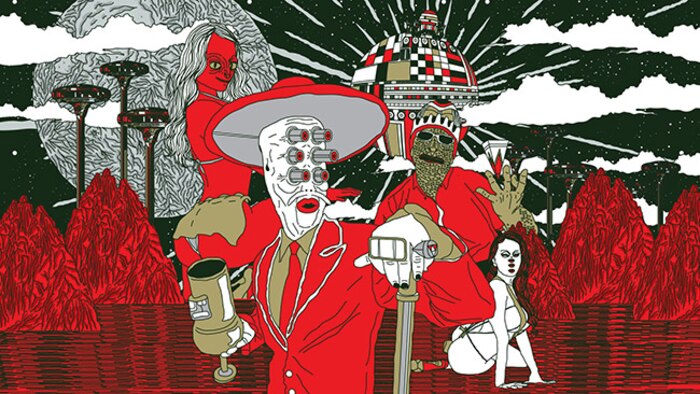Interstellar Overdrive: Distal’s Retrograde Space Opera
Outerspace bass dweller and RBMA New York 2013 grad Distal walks us through the atmosphere of some of his favorite tracks from his new Retrograde Space Opera.

Distal’s musical world perpetually lies in between Atlanta, Georgia and the Lost City of Atlantis. Since he got his start (around 2009), Michael Rathbun has continually been seeking ways to meld the Dirty South bass that is his roots music with the sci-fi/fantasy world that’s captured his imagination. Taking Marvel comics to the trap? A footwork journey through the galaxy? Dissolving aliens in a gurgling 303 acid bath? Distal’s done it, all with a deep reverence for dystopia and an Bart Simpson-esque sense of humor, whether delivering molten bass weight for Pinch’s Tectonic label or unpredictable club tracks for Grizzly, Seclusiasis, or his own Embassy label.
After a brief break to recuperate from making his 2012 album Civilization – and to regroup from the EDM wars currently wreaking havoc in the USA – Distal used the force to name himself captain of a new ship, the Anarchostar. He unleashed its first transmission this October: a 16-track opus called Retrograde Space Opera. With this album, Distal has reimagined himself as the cybernetic savior of a future world where black-market gangsters ride giant furry creatures through burning deserts and he must guide the people through a metaphysical wormhole in the center of the planet to save them… using music, of course. The release comes complete with an online graphic novel – drawn by Argentinian artist Freshcore – that explains the entire mission. See it here.
“Last year about this time, in the middle of the night, the Anarchostar story came to me,” recalls Distal. “I stayed up for hours writing out the whole story on my phone in bed. I woke up and realized I was only one or two pieces short of finishing the album. I feel like I had been molding that specific story throughout 2013 and hadn't known it.” Living in a run-down studio in Atlanta’s Five Points neighborhood with “an insane old lady landlord from an earlier time in the South,” he set about soundtracking the journey, fueled by autumn staples of the USA: homemade chili, pumpkin beers, and cartoons such as Bob’s Burgers and Space Dandy. At the end, he spent “Rain Man-level hours obsessing on the flow of the album,” something he learned from his record on Tectonic. “I think listening order has a lot to do with album composition, especially when you're trying to distance yourself from being a singles artist,” Distal explains.
Despite its dark narrative, Retrograde Space Opera, like any good epic, has plenty of moments of light peeking through the darkness, including “Sewers of Gattaca,” a bubbling aquatic confection featuring “field recordings of storm drains and dog-walking excursions,” and “Troposphere Cocktail Hour,” possibly the most fun slice of extraterrestrial jazz since Sy Snootles and the Rebo Band played the Star Wars cantina. Somehow, it reflects all the disparate influences that Distal has been taking in, from cartoons like Aeon Flux and Futurama to the experimental electronic sounds of Oneohtrix Point Never and Julia Holter; from the refracted darkness of Demdike Stare and Romanian Airspace to next-level comics like The Wicked + The Devine, Low, and Rai, which explore many of the same themes as his album.
We were intrigued, so we tracked down Distal around the 33.7550° N latitude and asked him for more insider details on some of the Retrograde Space Opera’s headiest moments.

Troposphere Cocktail Hour
“Far above the dying world, densely populated floating cities inhabit space. The very last of the upper class wait to be transported to their new homes on a distant planet. To keep the people occupied, the floating cities often descend into the troposphere of the planet below, and nightclubs spark up around them. These nightclubs are used by the upper echelon to strip themselves of their past sins and seek purification inside a new host body. The champion of the Anarchostar is a nightlife performer in these rituals. He’s brought up daily to perform. His job is to curate the music and party experience specifically around a particular individual's soul, enticing it out and trapping it in the club to find a new host. The hero often sees the souls as heartless and evil things, and feels turned off by the whole experience. Even his colleagues seem to have given in to evil and are overindulgent in their surroundings. He’s different, and close enough to the source of evil… That is why he was chosen.”
Nomodawah's Tomb
“Nomodawah is an old forgotten prophet of the Anarchostar. Once a renowned prophet of society and science, he was cast out by the water barons and government cronies who would see financial gain from the harvesting of the planet’s natural resources. He accepted his expulsion from society as a necessary part of the process for the chosen people. After the hero has become awake to the knowledge and power of the Anarchostar, he is guided to the Tomb of Nomodawah himself to seek the Ancient Scripture that will lead the way to the Anarchostar. After multiple unsuccessful entries into Nomodawah’s Tomb, the hero feels he might not actually be the chosen one and begins to question his own sanity.”
Ridge City
“The planet is dry and barren of its natural resources. The only inhabitable space on the planet is within the domed multiplex cities known as Ridge Cities. Traveling long distances between cities on foot or even by air is a near-impossible task. To remain connected, the cities are joined by lengthy highways. The highways themselves are split into three categories:
1) Old Roads: These roads are non-magnetic standard concrete roads. Traveling on these roads is not preferred as it takes considerably longer and the roads themselves are never maintained. Only the lowest of classes use these roads.
2) Magnetic Highways: These have guided tracking; they are better maintained and considerably faster than Old Roads. Magnetic cars are required on these roads.
3) Fly Paths: These are not connected to any physical structure but hang fairly low over the Magnetic Highways, often running parallel with them. The paths are only for those who can afford a flying vehicle. Sadly, most of the people who can afford the vehicles are gang members from the black market, corrupt politicians or gawking tourists from the floating cities above the planet.”
Boo Monde
“Fashion was a weapon of the mind. Boo Monde is from the French beau monde, meaning ‘fashionable society.’ The fashionable wealthy inherited the century-long modification of the word into ‘Boo Monde’ from the people planet-side who looked upon them as wandering ghosts from an earlier, more prosperous time. Their fashion seemed foreign to the planet-dwellers, although they were still humans underneath. They weren’t aliens but rather phantoms. The style of the wealthy citizens was often angular, bright and, unlike their human counterparts on land, was overly ambitious when it came to showing skin. The military and political elite wore dark, smooth, and conservative clothing that harkened back to earlier planetary tyrannical regimes. Often those in power would pay for surgery to turn their eyes red to instill fear among those below them. Warfare against and among the people began first in the mind. Keeping the people on the brink of starvation was the only way to control the masses. Fashion played a heavy hand in the war.”